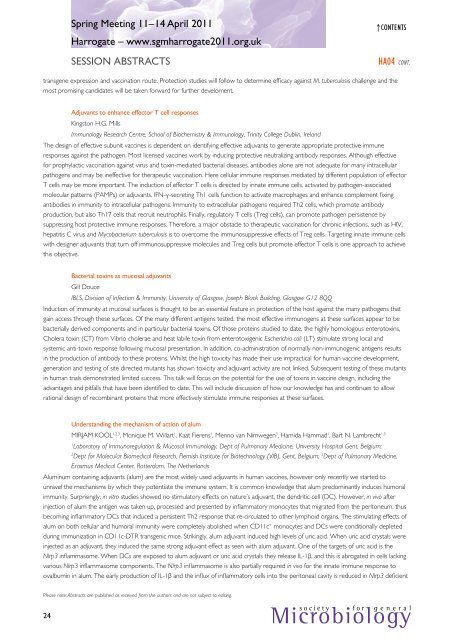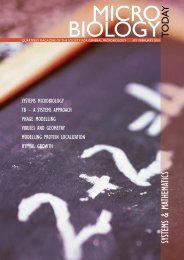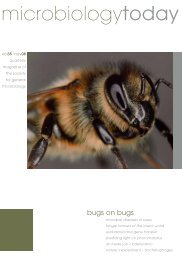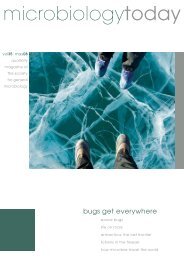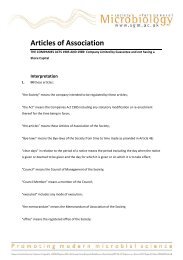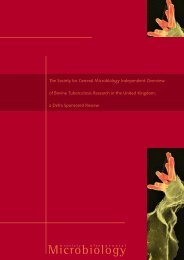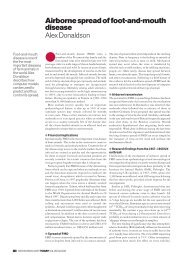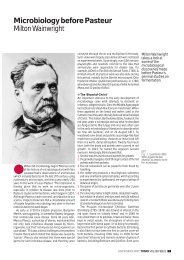Spring Conference 2011 - Society for General Microbiology
Spring Conference 2011 - Society for General Microbiology
Spring Conference 2011 - Society for General Microbiology
You also want an ePaper? Increase the reach of your titles
YUMPU automatically turns print PDFs into web optimized ePapers that Google loves.
Please note: Abstracts are published as received from the authors and are not subject to editing.<br />
24<br />
<strong>Spring</strong> Meeting 11–14 April <strong>2011</strong><br />
Harrogate – www.sgmharrogate<strong>2011</strong>.org.uk<br />
SESSION AbSTrACTS<br />
↑Contents<br />
HA04 Cont.<br />
transgene expression and vaccination route. Protection studies will follow to determine efficacy against M. tuberculosis challenge and the<br />
most promising candidates will be taken <strong>for</strong>ward <strong>for</strong> further develoment.<br />
Adjuvants to enhance effector T cell responses<br />
Kingston H.G. Mills<br />
Immunology Research Centre, School of Biochemistry & Immunology, Trinity College Dublin, Ireland<br />
The design of effective subunit vaccines is dependent on identifying effective adjuvants to generate appropriate protective immune<br />
responses against the pathogen. Most licensed vaccines work by inducing protective neutralizing antibody responses. Although effective<br />
<strong>for</strong> prophylactic vaccination against virus and toxin-mediated bacterial diseases, antibodies alone are not adequate <strong>for</strong> many intracellular<br />
pathogens and may be ineffective <strong>for</strong> therapeutic vaccination. Here cellular immune responses mediated by different population of effector<br />
T cells may be more important. The induction of effector T cells is directed by innate immune cells, activated by pathogen-associated<br />
molecular patterns (PAMPs) or adjuvants. iFN-γ-secreting Th1 cells function to activate macrophages and enhance complement fixing<br />
antibodies in immunity to intracellular pathogens. immunity to extracellular pathogens required Th2 cells, which promote antibody<br />
production, but also Th17 cells that recruit neutrophils. Finally, regulatory T cells (Treg cells), can promote pathogen persistence by<br />
suppressing host protective immune responses. There<strong>for</strong>e, a major obstacle to therapeutic vaccination <strong>for</strong> chronic infections, such as HiV,<br />
hepatitis C virus and Mycobacterium tuberculosis is to overcome the immunosuppressive effects of Treg cells. Targeting innate immune cells<br />
with designer adjuvants that turn off immunosuppressive molecules and Treg cells but promote effector T cells is one approach to achieve<br />
this objective.<br />
bacterial toxins as mucosal adjuvants<br />
Gill Douce<br />
IBLS, Division of Infection & Immunity, University of Glasgow, Joseph Black Building, Glasgow G12 8QQ<br />
induction of immunity at mucosal surfaces is thought to be an essential feature in protection of the host against the many pathogens that<br />
gain access through these surfaces. Of the many different antigens tested, the most effective immunogens at these surfaces appear to be<br />
bacterially derived components and in particular bacterial toxins. Of those proteins studied to date, the highly homologous enterotoxins,<br />
Cholera toxin (CT) from Vibrio cholerae and heat labile toxin from enterotoxigenic Escherichia coli (lT) stimulate strong local and<br />
systemic anti-toxin response following mucosal presentation. in addition, co-administration of normally non-immunogenic antigens results<br />
in the production of antibody to these proteins. Whilst the high toxicity has made their use impractical <strong>for</strong> human vaccine development,<br />
generation and testing of site directed mutants has shown toxicity and adjuvant activity are not linked. Subsequent testing of these mutants<br />
in human trials demonstrated limited success. This talk will focus on the potential <strong>for</strong> the use of toxins in vaccine design, including the<br />
advantages and pitfalls that have been identified to date. This will include discussion of how our knowledge has and continues to allow<br />
rational design of recombinant proteins that more effectively stimulate immune responses at these surfaces.<br />
Understanding the mechanism of action of alum<br />
MirJAM KOOl1,2,3 , Monique M. Willart1 , Kaat Fierens1 , Menno van Nimwegen3 , Hamida Hammad1 , Bart N. lambrecht1,3 1Laboratory of Immunoregulation & Mucosal Immunology, Dept of Pulmonary Medicine, University Hospital Gent, Belgium;<br />
2 3 Dept <strong>for</strong> Molecular Biomedical Research, Flemish Institute <strong>for</strong> Biotechnology (VIB), Gent, Belgium; Dept of Pulmonary Medicine,<br />
Erasmus Medical Center, Rotterdam, The Netherlands<br />
Aluminum containing adjuvants (alum) are the most widely used adjuvants in human vaccines, however only recently we started to<br />
unravel the mechanisms by which they potentiate the immune system. it is common knowledge that alum predominantly induces humoral<br />
immunity. Surprisingly, in vitro studies showed no stimulatory effects on nature’s adjuvant, the dendritic cell (DC). However, in vivo after<br />
injection of alum the antigen was taken up, processed and presented by inflammatory monocytes that migrated from the peritoneum, thus<br />
becoming inflammatory DCs that induced a persistent Th2 response that re-circulated to other lymphoid organs. The stimulating effects of<br />
alum on both cellular and humoral immunity were completely abolished when CD11c + monocytes and DCs were conditionally depleted<br />
during immunization in CD11c-DTr transgenic mice. Strikingly, alum adjuvant induced high levels of uric acid. When uric acid crystals were<br />
injected as an adjuvant, they induced the same strong adjuvant effect as seen with alum adjuvant. One of the targets of uric acid is the<br />
Nlrp3 inflammasome. When DCs are exposed to alum adjuvant or uric acid crystals they release il-1β, and this is abrogated in cells lacking<br />
various Nlrp3 inflammasome components. The Nlrp3 inflammasome is also partially required in vivo <strong>for</strong> the innate immune response to<br />
ovalbumin in alum. The early production of il-1β and the influx of inflammatory cells into the peritoneal cavity is reduced in Nlrp3 deficient<br />
s o c i e t y f o r g e n e r a l<br />
<strong>Microbiology</strong>


